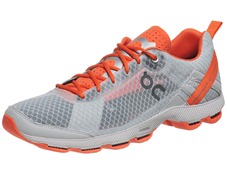 The running shoe world is full of companies claiming technological innovation in their footwear. Some of these so-called innovations are nothing more than gimmicks used to spin a good story in an effort to market and sell shoes, whereas others seem to actually provide some positive benefit. Some shoes have both – non-functional gimmicky technology as well as useful innovation in the same shoe (the Brooks PureCadence is a good example).
The running shoe world is full of companies claiming technological innovation in their footwear. Some of these so-called innovations are nothing more than gimmicks used to spin a good story in an effort to market and sell shoes, whereas others seem to actually provide some positive benefit. Some shoes have both – non-functional gimmicky technology as well as useful innovation in the same shoe (the Brooks PureCadence is a good example).
When I first saw the On Running cloud shoes my immediate gut response was that they were a total gimmick. On is a new company out of Switzerland, and like most shoe companies they incorporate a featured “technology” in their shoes (think Gel, Wave Plates, forefoot lugs, DNA, etc.). In the case of On, the technology consists of rubber pods on the sole that they refer to as “clouds.” The clouds collapse flat on contact, providing cushioning, and then once compressed they have little ridges that lock together to provide a firm base for push-off. At least that’s the idea.
I actually put off accepting a review pair of the On shoes for quite a long time because I wasn’t certain that they’d be a shoe that I’d like to run in. But, after hearing from a few readers that they liked the shoes, I decided to accept a pair of the On Cloudracers for a trial (disclosure: the shoes reviewed here were media samples provided by the manufacturer). So how well do they actually perform? Are the cloud pods a revolutionary technology that will forever change the running footwear landscape?
Of all of the On shoes, the Cloudracers are the most minimal, and would be classified as their racing flat. They are 6mm drop according to Running Warehouse (24mm heel:18mm forefoot), and weigh in at about 10oz in my size 10.5’s. The weight is an issue for a racing flat – in a market where most flats weigh in at 6oz or less, the Cloudracers are downright heavy. On likes to tout research conducted by the Swiss Federal Institute of Technology which apparently shows that subjects running in On shoes have a lower heart rate and lower lactate levels. I’d be interested to see the study since I’d like to know what shoe they were compared to – it has been repeatedly shown in the scientific literature that about a 3oz increase in shoe weight reduces running economy by 1%, and most competitor shoes to the Cloudracer weight at least 3 oz less, and in some cases as much as 6 oz less.
The weight of the of the Cloudracers is almost surely a result of the outsole, which features the rubber “Cloudtec” pods (more on this in a minute). The rest of the shoe is indeed quite minimal and really pretty nice. The upper is a very breathable, barely-there mesh with minimal overlays (you can see right through the upper in the photo above). The ankle collar is lightly padded and comfortable, and I had no issues with blistering or hot spots. Internally the Cloudracers are outfitted with a 5mm cushioned insole, which is fairly thick compared to other flats. The insole curls up medially to provide arch support, which is good or bad depending on you preference. Without the insole arch support is minimal. not sure how to describe it, but I really like the construction of the tongue.
The fit of the Cloudracers is fairly snug – you can tell from a top view of the shoe that like most flats, it’s not built on an anatomical last. That being said, I don’t find them constrictive and they’re fairly comparable to a Saucony Kinvara in terms of forefoot width. I did order a half size up in the On’s, and this was probably unnecessary as they fit a bit long on me. If you are considering them, order your usual size.
The sole of the On shoes is clearly the main selling point, and it’s what they’re marketing hard. As mentioned above, the idea behind the cloud pods is that they compress on contact, and once compressed, provide a firm base for push-off. You’ll notice in the side-view photo above that the pods on the heel are made of thicker rubber and are larger than those on the forefoot – this is important because it really speaks to who this shoe is designed for.
On my first few runs in the Cloudracers (I’ve run in them 5-6 times now) I honestly didn’t feel like they provided particularly notable cushioning. In fact, they felt rather firm to me, which isn’t necessarily a bad thing, but it’s not what I was expecting. I actually enjoyed running in them, though I wasn’t blown away, and the weight of all that rubber on the sole had a lot to do with that. I think that the issue for me is that most of the time I land either flat or only mildly to the forefoot or heel. The pods on the forefoot are thin and don’t provide much cushion, so the ride felt pretty firm. If you like a firm shoe that’s great, but the shoes are advertised to feel like “clouds,” and they definitely did not feel billowy underfoot.
After a few runs in them, I decided to try to consciously emphasize a heel strike. That’s when I had the a-ha! moment. When you land with a pronounced heel strike the heel pods provide fantastic cushioning, and the transition from heel to toe is really pretty nice. But, since I have to force myself to run this way and it feels awkward, I can’t keep it up for too long.
On does have a video in which they compare a heel-strike landing in their shoes to a more traditional running shoe, and it does look like the On shoes reduce vibration in the calf muscles a bit (not sure how much to conclude from this, and I’m sure the difference depends a lot on what you choose as the comparison shoe):
My conclusion is that the technology in this shoe is really designed for a pronounced heel-toe gait – big billowy pods on the heel to cushion initial impact that give way to thin, minimally bouncy pods on the forefoot that allow for a firm push-off. Thus, if this is how you run (and upwards of 90% of runners do run this way), I think the shoes do behave as advertised and could be a good choice. However, if you’re a midfoot or forefoot striker, there are better options that weigh much less.
Even if you are a heel striker, the weight of these shoes will likely be a turnoff if you’re looking for a racing flat (even the Brooks T7, which has a pretty substantial heel lift, weighs 3-4 ounces less). Dealing with this issue will be a challenge for On since the podded sole would seem to require a heavy rubber construction. This is a big drawback to building a shoe company around a signature technology – can you make an On shoe now without the Clouds? This is very similar to the position Newton is in – can they make a shoe without the forefoot lugs or are they bound to include them in every shoe they ever produce?
Aside from the weight, the other big issue with this shoe is the price tag. At $129 MSRP a shoe needs to really blow you away to justify paying a premium, and this one just doesn’t do it for me. I can spend $40-50 less and get a pair of Saucony Grid Type A5’s that weigh a 4oz less and provide just as much cushioning under the forefoot, or a pair of Brooks T7s that have plenty of cushion under the heel. In this sense the On’s are a also lot like Newton shoes – you pay a premium for the shoes and had better be pretty convinced that they’re going to be the best thing ever to justify the cost (incidentally, Newton also preaches durability, but On states on the Cloudracer webpage that you can expect to get 4-5 marathons out of them – I suspect the upper will be the first thing to break down). Do you want to spend $129 for a shoe that may only last 100-125 miles per the manufacturer’s own webpage? Not sure I’d recommend that risk. I’d guess that other shoes in the On line will have improved durability, but that comes with increased weight and in some cases an even higher price tag.
So to conclude, the On Cloudracers are a decent shoe, and what I thought would be a gimmicky technology does seem to work pretty well with a pronounced heel-striking gait. However, they are rather heavy for a racing/speed shoe and they’re pretty expensive for a shoe that the manufacturer claims will only get you through 4-5 marathons worth of mileage.
If you are inclined to buy a pair of On Cloudracers, they are in stock at Running Warehouse.
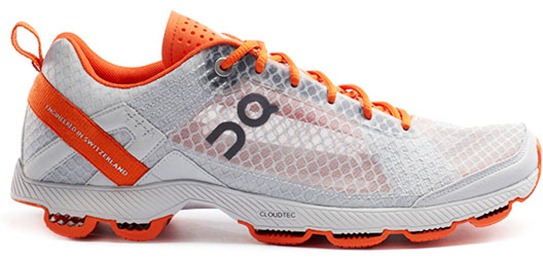

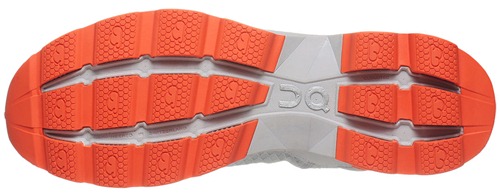
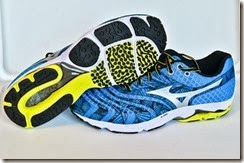
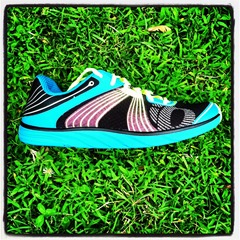
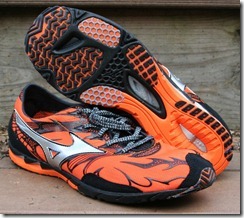
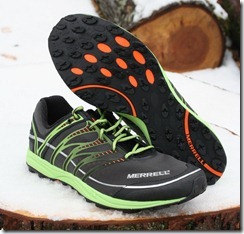
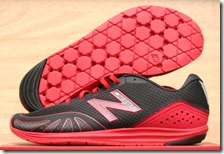














Doesn’t seem like the shoe for me, since I no longer heel strike, but perhaps by 4-5 marathons they include training miles too?
I considered the training miles, but for 4-5 marathons we’d be talking maybe 2000+ miles if you include training. That would be a pretty bold claim!
Sent from my iPad
The weight is already a turn off for me. Can’t seem to run with heavy shoes these days.
Looking at the slow motion video it shows that three things happen on the Cloud Races vs. the “traditional” trainer:
1) The pod compresses, but then so does EVA so I don’t see
this is as being anything unusual.
2) The pod shears, which would give a small and brief reduction in
the moment about the ankle forcing the toes down due to a
small reduction in the horizontal force.
3) The initial loading point is shifted forward vs the “traditional”
trainer, so that the moment arm about the ankle is reduced,
which in turn there is less moment about the ankle on
landing.
I would expect these effects to be most prominent on heel strikers that land with there foot sill moving forward. For runners which land with their foot still moving forward then item 2 disappears.
For runners that land flat footed, mid foot or forefoot then item 3 will be totally irrelevant. As you found ;-)
For the downsides, well there is the weight, this is going to increase the cost of recovering the foot from toe off to landing, so runners are likely to run with a lower cadence, longer stride length and longer time on stance. The runner will be less efficient than they would be with a lighter shoe.
Where the claimed improved efficiency might come from… my guess it’s the conditions of the tests done and what they were comparing against rather anything from the shoe. The only area where I think there might be an improvement is that if you are a heavy heel striker and use the shin muscles significantly then loading them less will result in less energy used in activating them on loading.
For a runner who has a healthy gait I would expect the pods to offer no advantages. For the a runner with a unhealthy gait (heavy heel strike) and used to running in heavy shoes it may help elevate some of the side effects of the problems in the gait.
Personally I think a low and undercut heel is a much simpler solution to reducing the side effects of a heavy heel strike in terms of moment about the heel. Cutting away material rather adding material will also reduce weight which provides other benefits to the overall gait in terms of cadence and stride length.
Thanks Robert, I always appreciate your engineering take on things like this.
You might enjoy this ad disguised as an article about the On shoes: link to espn.go.com…
—-
Pete Larson’s Web Links:
-My book: Tread Lightly: link to ow.ly
-Blog: https://runblogger.com
-Twitter: link to twitter.com
-Facebook Page: link to facebook.com…
-Discussion Forum: https://runblogger.com/forum
Thanks Robert, I always appreciate you engineering perspective! You might enjoy this take on the shoes :)
link to espn.go.com…
The article looks like a classic case of ad discussed as an independent article, either that of the author has serious lack of critical thinking. When Ms. Steffan improves her marathon time by 7 minutes it’s down to the shoe not the 20% extra mileage she’s done in training…
As for the foot slap, this is a sign that bending moment about the ankle significantly exceeds the opposing moment generated by the shin muscles. The rapid eccentric loading of the shin muscles just makes me wince, no wonder why shin splints is so common in heel strikers. Cutting down this moment has to be a good thing.
However, while making life for a heel striker more bearable might be one solution it’s one that doesn’t encourage one to migrate to a better foot orientation on landing. If you use the foot as it evolved to be used when running you don’t need all this fancy crap on the shoe to compensate for heel striking and instead you can have a lighter and more responsive shoe.
I feel that much of “design” of most modern running shoe is about compensating for crap introduced by the shoe itself and lifetime of wearing similarly badly designed shoes.
Well said!
—-
Pete Larson’s Web Links:
-My book: Tread Lightly: link to ow.ly
-Blog: https://runblogger.com
-Twitter: link to twitter.com
-Facebook Page: link to facebook.com…
-Discussion Forum: https://runblogger.com/forum
The more I watch that video, the more I think it’s not so much that impact is different, but rather that the “traditional” shoe has a very pronounced foot slap and that it’s the post impact heel-toe transition that differs.
Very interesting point of view. I was recently given a pair of CloudRacers by their French representative. I thought they might be compatible with my flat midfoot strike which wasn’t the case at all. Instead of giving me an energy boost, they deadly slowed me. I gave them to a heel striker who immediatly became at ease with them and thought his performances were improved by the sole. Obviously you fully agree :-)
I had a pair but gave them away after some ten runs because…
a) They’re heavy and slowed me down.
b) When it’s wet outside they’re slippery.
c) They’re totally useless in terrain, no traction, and again slippery.
d) On fire roads gravel gut stuck in the pods.
They were somewhat okey on the local 400 meter oval and for warm-ups and cool-downs on asphalt on hot, dry days though…
I had wondered about gravel getting stuck in the pods, haven’t experienced it myself, but seems like it could be an issue.
—-
Pete Larson’s Web Links:
-My book: Tread Lightly: link to ow.ly
-Blog: https://runblogger.com
-Twitter: link to twitter.com
-Facebook Page: link to facebook.com…
-Discussion Forum: https://runblogger.com/forum
Interesting take. I just got a pair of the CloudSurfers and absolutely LOVE them. I must have 10 other pairs of shoes outside that I typically rotate through the week but since the ONs have arrived I’ve reached for them every time. I def am that heel striker runner and these are magic for me! I used them for a marathon yesterday and have almost no quad soreness this morning, which is a first for sure. I feel like I want to ditch all my other shoes and order 3 more pairs of clouds.
This looks like an accident waiting to happen. I have had two running injuries in my life and they both happened when I tripped due to having too much sole beneath my feet. Due to the slowed rate of motion these shoes provide reaction times will also be slowed.
Heel striking and a low cadence slows reaction time anyways but now you have to deal with getting past pods and EVA. The ability to change directions to avoid potholes, rattle snakes, and the occasional used car salesmen will be greatly reduced.
What baffles me though is why would they give a shoe a minimal heel lift if it’s only good for heel striking?
On a side note: I wouldn’t be caught dead wearing these myself. (no offense to anyone who does) I’d feel like people would think I needed a cane just to get around.
Bought the cloudsurfer a few months back and totaled about 440 miles including several marathons. The shoes are at a point where one of the cloud pods is about to wear through so I am looking for new shoes. I am contemplating getting the cloud racer.
My experience with the surfer model (which should apply to the racer) has been positive. My previous shoes were mostly from Nike. The ON shoes are better ventilated and the “clouds” seem to offer better damping and got rid of shin splints, calf soreness and black toes I usually get with other brands.
They are reasonably light weight. The thicker heal pods saved me a few times on steep downhills. They did not get in the way when running sub 6 pace mid-foot.
Only issue was when I ran Paris on cobblestones. My forefoot was sore the second half. I certainly would consider buying them again provided I don’t get bored with them. By the way, the price is all inclusive (tax and s/h). They arrived at my doorstep two days after ordering them. The surfer model seems to have gone up in price by $10. I think its a bit steep for those shoes.
Worst shoes I ever owned!
Parts of the sole broke after 40 kms (2 runs). I returned them but they had forgotten to give me a prepaid return waybill (they advertise easy, free return). I requested a waybill on their website and never had an answer. After more than 2 weeks waiting for an answer, I sent it back using the same delivery method. Samara, the Canadian’s customer service representative, told me she would take care of the bill in September, again in October, and in December. We currently are in January and my bill still has not been taken care of.
I would not recommend these shoes to any long distance runners